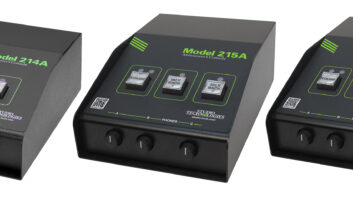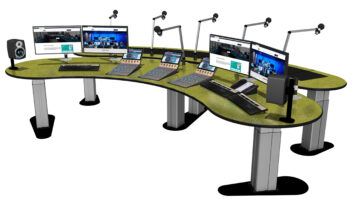BRUSSELS — RTBF’s “media-studio” concept, built in 2015, inspired the broadcaster to follow suit for the studio of its news channel, La Première.
The Belgian French-language public broadcaster recently designed and built La Première’s new studio, and key elements of the media studio were projected in an on-air landscape combining “self-op” and a control room.

NEW APPROACH
“La Première’s new on-air studio has been built for multimedia purposes,” explained Laurent Finet, head of Production and Digital Radio Innovation. “We dedicated lots of attention to the visual aspect and the cross-media approach of the studio, allowing us to use content for the different media platforms we are active on.”
Does this mean the end of “traditional radio” as we know it? Finet doesn’t think so. “For me, it’s everything but the end of radio,” said Finet. “People have been saying for years that streaming marks the death of radio. But radio will never die. … Just think about the traffic problems in Belgium — people are directed to their radio more than ever, even if it’s in their cars picking up traffic information.”
Finet admitted that young audiences are more future-oriented than the average over 40-year-old listener who’s still attached to the medium. “But there is massive potential — we should evolve more into ‘enhanced radio,’” he said. “When we add images, they should be more than just a presenter in a radio studio — this requires imaging like for TV.”

La Première’s radio studio is RTBF’s first full-service format on-air studio with integrated “self-op” technology. But complex programs like “Matin Première” (6 to 8 a.m.) with plenty of news and interviews still require an engineer. “We have already introduced ‘self-op’ for musical programs and we are training the on-air staff to increase ‘self-op’ in the future,” added Finet.
“Combining radio and TV has consequences for the presenters: they must face the camera and have to get used working without notes, since a journalist going beyond their written text enhances the program’s dynamics, even during a news bulletin,” he said.
“In the ‘self-op’ setup, we use a Dan Dugan E-3A automatic mixing controller for the microphones. It switches on the microphones, cuts background noise in the studio and triggers the voice-controlled cameras. A studio engineer can then concentrate on the mixing of images captured by the robot cameras.”
NO COMPROMISES
The main engine of the new studio, which was refurbished by DHD distributor and systems integrator Amptec, is a DHD 52/XD2 DSP-core with redundant MADI to RTBF’s central router. The XD2 has optical links to the studio where three DHD 52/XC2 Concentrator units group technical elements like consoles, panels and in/out boxes. “The use of Concentrators helped us to have less ‘physical’ hardware in the studios,” said Bart Lamberigts, Amptec project manager.
[Read: RTBF Gears up for Smart Radio]
The broadcaster uses a DHD 52/MX 24-fader console in the control room during “assisted’ broadcasts and the presenter has a DHD 52/MX 12-fader desk. Both the engineer and DJ spots are equipped with DHD 52/TX touchscreen consoles, used for monitor and talkback functions.
Finet decided to continue using Neumann TLM 102 microphones. “TV producers may say these huge microphones are not the ideal solution, but for a radio program, there are no compromises as to the quality of the audio signal,” he said.
He highlighted the fact that the new on-air studio and control room, ergonomics, technical solutions, self-op usage and the telephone management system, were designed in close collaboration with technicians and presenters.

“We’ve invested in a Broadcast Bionics Phonebox for all incoming signals like telephone, codecs, Facebook and Skype to facilitate the job of a self-op DJ by having just one interface. The next step will be a central metadata bank where we can catalog interactive audience input. The presenter will then get to know who’s on the other side. The Phonebox system interacts seamlessly over IP with the DHD environment, both for audio and control,” said Finet.
INTERIOR DESIGN
The presenter’s desk has four built-in touchscreen displays for Phonebox, a Netia RadioAssist 8 playout system, the DHD 52TX, a Mandozzi IDEA matrix (grouping audio signals from RTBF Brussels and regional studios before transmission) plus the DHD MX console, and network tools such as OpenMedia NRCS, Office suite, internet.
“The integration of these elements was quite complex,” confessed Finet. “The furniture has been specially designed to fit the TV images. And these images are important, but we must never break the magic of radio. The challenge was to integrate the technical equipment in the on-air studio without being visible. Amptec and our TV specialists did a great job.”
La Première’s control room is staffed by a team of four. These include a sound engineer operating the DHD console, a video image mixing engineer, an assistant handling the program flow, phones and guests and a social media editor.
“I think the social media editor’s presence in the control room adds to on-air dynamics,” said Finet. “Quotes can immediately be edited and shared on social media — quite efficient.”
In the control room, Amptec installed three calibrated Empirical Labs EL8x Distressor processors and an IHSE-platform for KVM extending and switching. “The Distressors are part of the voice chain, adding a specific signature to the voice,” added Lamberigts.












